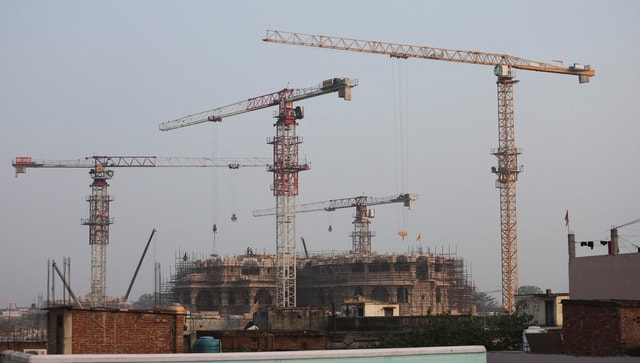Ram Mandir inauguration: Did Nihang Sikhs start the temple movement over a century back?
In November 1858, Nihang Baba Fakir Singh Khalsa barged into Babri Masjid in Ayodhya, conducted a hawan and wrote 'Ram Ram' on the walls of the mosque. Now, his eight descendant has decided to organise a langar during the consecration of Lord Rama in the city next month
A religious flag is seen in front of the under-construction Hindu Ram Temple in Ayodhya on 9 July 2023. Reuters File Photo
The consecration ceremony of the Ram Temple in Ayodhya will be held a month from today (22 December). Preparations are in full swing and are now in the final stages.
From revered saints to political leaders, actors and entrepreneurs, invitations are being sent to prominent personalities for the grand opening of the temple.
Recently, a Nihang Sikh declared he would organise ‘langar sewa‘ (Sikh community kitchen) during the consecration of Lord Rama in Ayodhya on 22 January 2024. His announcement has brought to the limelight the connection of Sikhs to the Ram Janmabhoomi.
Let’s take a closer look at the story.
Guru Nanak Dev’s Ayodhya visit
As per reports, Guru Nanak Dev, the founder of Sikhism, visited the site of Ram Janmabhoomi in Ayodhya in 1510-11 AD. Babri Masjid was not constructed at the time.
In its verdict on the disputed religious site in the Uttar Pradesh city in November 2019, the Supreme Court had taken note of Guru Nanak Dev’s visit which it said showed pilgrims went to see the site even before 1528 AD.
“It is found that in period prior to 1528 AD, there were sufficient religious texts, which led Hindus to believe the present site of Ram Janmabhoomi as birthplace of Lord Ram,” the apex court said in its judgement, as per Times of India (TOI).
Nihang Sikhs and Ram Janmabhoomi
In November 1858, Nihang Baba Fakir Singh Khalsa barged into Babri Masjid in Ayodhya as a posse of 25 Nihang Sikhs stood guard outside.
He erected a symbol of ‘Sri Bhagwan‘ (Lord Ram) inside the mosque and wrote ‘Ram Ram’ on the walls of the Muslims’ place of worship, reported India Today.
Baba Fakir Singh also organised a hawan and puja inside the mosque.
The Nihang Sikhs also set up a platform inside the place of worship on which an idol of Lord Ram was placed, according to TOI. After this, a case was registered against the 25 Nihangs at the Oudh (as Ayodhya and nearby areas were called then) police station based on a complaint by Syed Mohammad Khateeb, the then muezzin (mosque’s officer) of the Babri Masjid, who called the incident an “open tyranny and high-handedness of the Hindus on Muslims”, as per India Today.
“Because of conspiracy of Shiv Ghulam Thandedar Oudh government, the Bairagis (Nihangs) constructed overnight a chabutra (platform) up to height of one ‘Balisht’ until the orders of injunction were issued,” he reportedly said in the complaint.
A report by the Thanedar of Oudh, Sheetal Dubey, in November 1858, which was mentioned by the Supreme Court during its 2019 ruling, stated: “Today Nihang Singh Faqir Khalsa, a resident of Punjab, organised Hawan and Puja of Guru Gobind Singh and erected a symbol of Sri Bhagwan, within the premises of the Masjid. At the time of pitching the symbol, 25 Sikhs were posted there for security.”
It further said that Dubey had summoned Baba Faqir Singh and admonished him. Despite this, Baba continued to insist that “every place belonged to Nirankar (the formless divine)”, reported Indian Express.

The incident had flared up commnual tensions, with local Muslims complaining of facing problems in offering namaz at the Babri mosque.
“The Azaan of Moazzin was met with the blowing of conch shells by Hindus. A contentious situation was arising. The Nihang Sikh was evicted from the site and a record was maintained,” the apex court observed in its 2019 verdict, reported TOI.
Recalling this incident, the eighth descendant of Baba Fakir Singh, Jathedar Baba Harjit Singh Rasulpur, announced on Sunday (17 December) that he will hold a langar to serve devotees coming for the Pran Pratishtha or consecration ceremony of the Ram Temple.
He said he wanted to carry forward the devotion of his ancestor towards Lord Ram by organising the langar along with other Nihangs. “Now, when the Pran Pratishtha of Lord Rama is being done on 22 January 2024, how can I lag behind?” he was quoted as saying by Indian Express.
“I have no affiliation with any political party and am only a bearer of eternal traditions. I had to face criticism while maintaining harmony between Nihangs and Sanatan Dharma because, on the one hand, I am an amritdhari (baptised) Sikh, but on the other hand, I wear rudraksha mala around my neck,” Baba Harjit Singh told the media in Chandigarh.
Nihangs are a distinct sect among the Sikhs, who are known for their martial skills. This order of Sikh warriors is identified by their loose, dark blue robes, turbans adorned with steel quoits (chakrams) and traditional arms such as swords and spears.

In October, Defence Minister Rajnath Singh said in Lucknow that it was Sikhs who “started the Ram Janmabhoomi movement”, according to Hindustan Times (HT).
Speaking at Guru Granth Sahib Parkash Utsav at Lucknow’s Gurudwara Alambagh, he said, “It was Sikhs who started the Ram Janmabhoomi movement and their contribution can never be forgotten by any Indian. The Sikh community has done a lot to protect the Sanatana Dharma”.
Singh also talked about the 1858 incident involving Nihang Baba Fakir Singh Khalsa.
With inputs from agencies

No comments:
Post a Comment